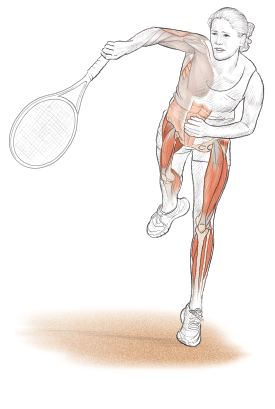Overhead rotational medicine ball slam
This is an excerpt from Tennis Anatomy-2nd Edition by E Paul Roetert,Mark Kovacs.

Execution
- Stand with your feet shoulder-width apart. Hold a medicine ball (start with a 4- to 6-pound [2 to 3 kg] medicine ball), and keep the core tight and stable.
- Keeping an upright posture, raise the medicine ball above your head with straight arms.
- Using an explosive movement, turn the hips to the right, and throw the ball down into the ground approximately 1 to 2 feet away from your right foot. Make sure to use a full triple-extension (ankle, knee, and hip) movement before throwing the ball into the ground.
- Pick up the ball, return to the starting position, and repeat the movement to the left side.
- Repeat for the appropriate number of repetitions.
Muscles Involved
Primary: Gluteus maximus, gluteus medius, rectus femoris, vastus intermedius, vastus lateralis, latissimus dorsi, gastrocnemius, soleus
Secondary: Rectus abdominis, transversus abdominis, serratus anterior, triceps brachii
TENNIS FOCUS
The overhead medicine ball slam movement is valuable for tennis because of its rotational nature and the shifting of the center of mass to above your head and then explosively shifting the weight downward. This movement is specifically applicable to high groundstrokes (forehand and backhand) as well as for power production for the serve and overhead. The improvement in power production is an important aspect of tennis-specific training, and the rotational and overhead movement is a way to incorporate multiple aspects of training in a single exercise. The movement outlined here (just like quality tennis strokes) requires good balance, control over the center of gravity, and proper posture.

SHOP

Get the latest insights with regular newsletters, plus periodic product information and special insider offers.
JOIN NOW


